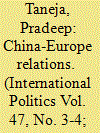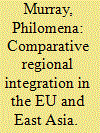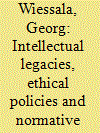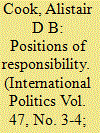|
|
|
Sort Order |
|
|
|
Items / Page
|
|
|
|
|
|
|
| Srl | Item |
| 1 |
ID:
098793


|
|
|
|
|
| Publication |
2010.
|
| Summary/Abstract |
The China-European Union (EU) relationship has grown rapidly over the past three decades with international trade being its mainstay. China and the EU also share a number of common strategic interests and positions. To maximize the potential of this relationship, both sides decided to build a comprehensive strategic partnership. However, serious differences remain between the two sides on questions of norms and values, delaying progress on a strategic framework. This article argues that while these differences constitute a serious obstacle to the realization of a genuine strategic partnership, the growing importance of trade and investment relations between China and the EU will cushion the impact of these differences, thus allowing each side more leverage over the other in dealing with complex bilateral and international issues.
|
|
|
|
|
|
|
|
|
|
|
|
|
|
|
|
| 2 |
ID:
098785


|
|
|
|
|
| Publication |
2010.
|
| Summary/Abstract |
In comparative regional integration (RI) analysis, the European Union's (EU) advancing of its own experience as a model is a significant problem. This article explores this problem by focusing on comparative aspects of RI in the EU and East Asia. It argues that there are important and valid aspects of comparison, such as the origins and objectives of these two regions, but fewer points of comparison between the two when it comes to achieving their objectives. It suggests that historical differences between the two regions constitute the major reason that a direct comparison is neither useful nor productive. It analyses the centrality and the exceptionalism of the EU in much of the comparative RI literature. It agues that the promotion of the EU experience as a form of model or paradigm is far from analytically helpful - the method of comparative analysis needs be the focus of our study as much as the objects of comparison. The article examines how the centrality of the EU in some analysis can amount to a form of de facto snobbery in the positioning of the EU on a rather unsteady pedestal. This 'integration snobbery' - to coin a phrase utilized by an EU official - is not constructive for comparative analysis of the EU and East Asia.
|
|
|
|
|
|
|
|
|
|
|
|
|
|
|
|
| 3 |
ID:
098796


|
|
|
|
|
| Publication |
2010.
|
| Summary/Abstract |
The article critically explores how, and in what ways, the EU and ASEAN have addressed contemporary security issues, including non-traditional security threats. The comparison of the EU and ASEAN responses to these threats highlights the different forms and functions that regional integration has taken in Europe and Southeast Asia, and the implications of these differences for intra- and extra-regional security cooperation. The article considers how the EU and ASEAN might work more cooperatively together, noting some existing examples in which experiences and good practice are already shared, as well as other areas in which cooperation might be possible. The article concludes that while security cooperation in the EU and ASEAN, as well as between the two regional entities, is problematic, reflecting differing regional and national interests and organisational capabilities, there are concrete areas in which cooperation is possible.
|
|
|
|
|
|
|
|
|
|
|
|
|
|
|
|
| 4 |
ID:
098795


|
|
|
|
|
| Publication |
2010.
|
| Summary/Abstract |
In recent years, there has been considerable scholarly and policy community attention accorded to comparisons between the EU's monetary integration and attempts to create monetary integration in East Asia. This article examines these attempts in comparative perspective, focusing in particular on the challenges of monetary integration in Asia. After explaining recent development of financial and monetary cooperation initiatives in East Asia, such as Post-Chiang Mai Initiative and the attempt to introduce a Regional Currency Unit (RCU), this article illustrates why it is preferable for East Asia, in its attempt to pursue monetary integration, to follow a path similar to the European experience, rather than to follow alternative paths such as a parallel currency approach or a harmonized inflation targeting. That RCU could in the future be issued by the so-called 'Asian Exchange Rate Stabilization Fund' (AERSF). The AERSF would assure the stability of regional currencies taken as a whole vis-à-vis third currencies, and between themselves as well, and as such, pave the way for full monetary integration in Asia. Comparisons with Europe are explored and implications for European and Asian regionalism are examined.
|
|
|
|
|
|
|
|
|
|
|
|
|
|
|
|
| 5 |
ID:
098789


|
|
|
|
|
| Publication |
2010.
|
| Summary/Abstract |
European Union (EU)-Asia relations raise linked problems (on the one hand) of EU collective action and identity and (on the other hand) of cooperation. The relationship is characterized by complexity and variety in three dimensions: first, 'voices' and history; second, institutional engagement and structure; and third, issue structure. In order to explore the implications of this complexity and variety, and to generate propositions for further research, we deploy International Relations theories based on material interests, ideas and institutions. These help us to demonstrate not only the application of 'analytical theory' but also the role of 'practitioner theory' in the evolution of relations between the EU and Asia, and thus to reflect systematically on the problems of collective action and cooperation identified at the beginning of the article.
|
|
|
|
|
|
|
|
|
|
|
|
|
|
|
|
| 6 |
ID:
098787


|
|
|
|
|
| Publication |
2010.
|
| Summary/Abstract |
For much of the second half of the twentieth century, regionalism has been conceptualized with reference to Europe. The European Union (EU) is seen as the most successful example of regional integration and this 'model' is largely based on an exclusive 'institutional' regionalism where integration is achieved through endowing specific institutions with far-reaching decision-making powers to shape the behaviour of the member states. In contrast, the East Asian region-building process seems to operate on a different logic, with an emphasis on open-ended networked regionalism. This article sketches out the process of regional construction in Europe and East Asia and attempts to develop and contextualize the idea of networked regionalism in order to assess how useful it can be in explaining the trajectory and contours of region-building in East Asia.
|
|
|
|
|
|
|
|
|
|
|
|
|
|
|
|
| 7 |
ID:
098797


|
|
|
|
|
| Publication |
2010.
|
| Summary/Abstract |
This article investigates EU foreign policies regarding Human Rights with Asia. The perspective adopted here argues for a consideration of selected, social-constructivist, perspectives. The article emphasizes ideas, identities, values, educational exchange and human rights in EU policy towards Asia. Through a number of case studies, the article demonstrates that there is both an 'enabling' and an 'inhibitory' human rights dynamism in EU-Asia dialogue. The article suggests some ways of translating this into policies. It proposes a more inclusive, 'holistic', understanding of human rights discourse in East-West relations.
|
|
|
|
|
|
|
|
|
|
|
|
|
|
|
|
| 8 |
ID:
098798


|
|
|
|
|
| Publication |
2010.
|
| Summary/Abstract |
Recent challenges have tested the approaches of both the Association of Southeast Asian Nations (ASEAN) and the European Union (EU) to adequately respond to forced migration in Myanmar. This article provides a comparison between the European sanctions regime and ASEAN's 'constructive engagement' with Myanmar. In the aftermath of Cyclone Nargis, it is ASEAN, along with the United Nations (UN), that has offered an effective mechanism to access populations of concern in Myanmar. This article draws on the experience of the UN High Commission for Refugees on the western border and argues that while the new ASEAN-UN-led mechanism offers a new way to assist people in the delta region, this access is contingent on three constraints: maintenance of personal relations with military decision-makers, continuation of an ASEAN-UN-led mechanism and ongoing funding from donor nations.
|
|
|
|
|
|
|
|
|
|
|
|
|
|
|
|
| 9 |
ID:
098791


|
|
|
|
|
| Publication |
2010.
|
| Summary/Abstract |
This article argues that multidimensional regional processes have an external projection that may be explained by their semi-liberal governance structures. It analyses the European Union (EU) and the East Asian grouping of countries, focussing on the Association of Southeast Asian Nations (ASEAN) and the active participation of Japan, South Korea and the People's Republic of China within ASEAN Plus Three. Both regional processes have a multi-level external projection as seen in their links with key states (especially the United States), other regional processes, and global regimes like the UN and the G20. In both cases, one finds that public actors have to collaborate with private actors, although they do so in a restricted fashion and often using think tanks and elite public-private intellectual (track-2) actors. The comparative analysis concludes with some hypotheses regarding the consolidation of regional processes in the world.
|
|
|
|
|
|
|
|
|
|
|
|
|
|
|
|
|
|
|
|
|